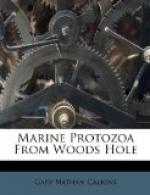Small, colorless (except for ingested food) animals with characteristic springing movements. The form is usually constant, but in some cases may be plastic like Astasia; it is usually globular or conical, the posterior end being more or less pointed, the anterior end broadest. The latter is surrounded by a complete circle of the adoral zone, the oral end of which passes into a peristomial depression which extends deep into the middle of the body. The mouth, with a very small oesophagus, lies at the bottom of the inturned peristome. The region surrounded by the adoral zone is frequently drawn out into an anterior process, occasionally bearing a pigment mass. The ventral surface in some cases bears cilia, which may be distributed or restricted to a row of large cilia. Trichocysts are usually present and may be widely spread, limited to the posterior region, or arranged in a girdle about the middle. The contractile vacuole is simple, and posterior in position. The macronucleus is spherical and usually central in position. Movement is rapid swimming, combined with resting and floating periods, the latter usually terminated by a sudden leap.
Fresh and salt water; more common in the latter.
Strombidium caudatum Fromentel ’74. Fig. 46, a, b, c.
Fromentel described a fresh-water form of this genus with a caudal appendage. The body is pyriform, broadly truncate on the anterior end, in the middle of which rises a papilliform process (Schnabel). On this process is a heap of pigment granules, which, however, are not constant. A ring of long cirri surround the anterior end and pass into the peristome, and from the left edge of this line of cirri a large adoral zone continues down to the mouth. The peristome is elongate and sac-form, and the mouth lies at the posterior extremity. With the exception of a caudal filament there are no other motile organs; this is about half as long as the body, structureless, hyaline, and sharply pointed. It splits up into a bundle of fine fibers upon treatment with caustic potash (c). The cirri emerge from minute hollows in the edge of the anterior border. The cortical plasm contains peculiar rod-like bodies, which look more like lines or markings than like rods or trichocysts. The nucleus is large, spherical, and placed in the center of the body. The contractile vacuole is posterior.
Length without appendage is about 35 mu; greatest
diameter 15 to 18 mu.
In decaying vegetable matter. Common.
[Illustration: Fig. 46.—Strombidium caudatum.]
Although Fromentel’s species is incompletely described, it is very evident that the organism corresponds fairly well with the Woods Hole variety. His was a fresh-water type; this is marine, but the caudal filament and the contractile vacuole are similar. Certainly in this case the organism can not be regarded as a Vorticella broken off its stalk, as Kent ’81 suspected. The anterior process with its pigment spot; the cirri, the spherical nucleus, the position of the vacuole, etc., are all opposed to such an interpretation which Kent applied to the original species. Neither can it be a Tintinnoid. I place it provisionally as S. caudatum.




